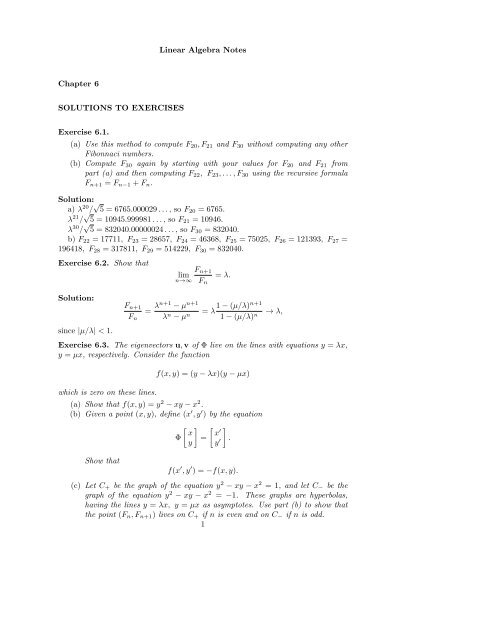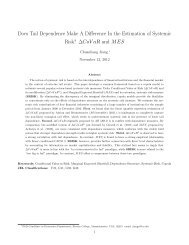Linear Algebra Notes Chapter 6 SOLUTIONS TO EXERCISES ...
Linear Algebra Notes Chapter 6 SOLUTIONS TO EXERCISES ...
Linear Algebra Notes Chapter 6 SOLUTIONS TO EXERCISES ...
Create successful ePaper yourself
Turn your PDF publications into a flip-book with our unique Google optimized e-Paper software.
<strong>Linear</strong> <strong>Algebra</strong> <strong>Notes</strong><br />
<strong>Chapter</strong> 6<br />
<strong>SOLUTIONS</strong> <strong>TO</strong> <strong>EXERCISES</strong><br />
Exercise 6.1.<br />
(a) Use this method to compute F 20 , F 21 and F 30 without computing any other<br />
Fibonnaci numbers.<br />
(b) Compute F 30 again by starting with your values for F 20 and F 21 from<br />
part (a) and then computing F 22 , F 23 , . . . , F 30 using the recursive formula<br />
F n+1 = F n−1 + F n .<br />
Solution:<br />
a) λ 20 / √ 5 = 6765.000029 . . . , so F 20 = 6765.<br />
λ 21 / √ 5 = 10945.999981 . . . , so F 21 = 10946.<br />
λ 30 / √ 5 = 832040.00000024 . . . , so F 30 = 832040.<br />
b) F 22 = 17711, F 23 = 28657, F 24 = 46368, F 25 = 75025, F 26 = 121393, F 27 =<br />
196418, F 28 = 317811, F 29 = 514229, F 30 = 832040.<br />
Exercise 6.2. Show that<br />
Solution:<br />
since |µ/λ| < 1.<br />
F n+1<br />
= λn+1 − µ n+1<br />
F n λ n − µ n<br />
F n+1<br />
lim = λ.<br />
n→∞ F n<br />
= λ 1 − (µ/λ)n+1<br />
1 − (µ/λ) n → λ,<br />
Exercise 6.3. The eigenvectors u, v of Φ live on the lines with equations y = λx,<br />
y = µx, respectively. Consider the function<br />
which is zero on these lines.<br />
f(x, y) = (y − λx)(y − µx)<br />
(a) Show that f(x, y) = y 2 − xy − x 2 .<br />
(b) Given a point (x, y), define (x ′ , y ′ ) by the equation<br />
Show that<br />
[ ] [ ]<br />
x x<br />
′<br />
Φ =<br />
y y ′ .<br />
f(x ′ , y ′ ) = −f(x, y).<br />
(c) Let C + be the graph of the equation y 2 − xy − x 2 = 1, and let C − be the<br />
graph of the equation y 2 − xy − x 2 = −1. These graphs are hyperbolas,<br />
having the lines y = λx, y = µx as asymptotes. Use part (b) to show that<br />
the point (F n , F n+1 ) lives on C + if n is even and on C − if n is odd.<br />
1
2<br />
A picture to accompany this exercise will be drawn in class.<br />
Solution:<br />
a) Since (x − λ)(x − µ) = x 2 − x − 1, we have λ + µ = 1 and λµ = −1. Hence<br />
(y − λx)(y − µx) = y 2 − (λ + µ)xy + λµx = y 2 − xy − x 2 .<br />
b)<br />
f(x ′ , y ′ ) = (y ′ ) 2 −x ′ y ′ −(x ′ ) 2 = (x+y) 2 −(x+y)y −y 2 = −y 2 +xy +x 2 = −f(x, y).<br />
c)<br />
f(F n , F n+1 ) = −f(F n−1 , F n )<br />
= (−1) 2 f(F n−2 , F n−1 )<br />
= · · ·<br />
= (−1) n f(F 0 , F 1 )<br />
= (−1) n f(0, 1)<br />
= (−1) n .<br />
Exercise 6.4. The “Lucas numbers” are defined like the Fibonaccis, except the two<br />
starting values are L 0 = 2, L 1 = 1. Thus, L 2 = 3, L 3 = 4, L 4 = 7, etc. Using<br />
the method of this chapter, find a formula for L n that does not require computing<br />
any other Lucas numbers. (Note the same matrix Φ is used, but the initial vector<br />
is different).<br />
Solution:<br />
[ ] [ ]<br />
Ln<br />
= Φ n 2<br />
L n+1 1<br />
= √ 1 [ ] [<br />
λ n−1 − µ n−1 λ n − µ n 2<br />
5 λ n − µ n λ n+1 − µ n+1 1<br />
]<br />
,<br />
So<br />
L n = 1 √<br />
5<br />
[2(λ n−1 − µ n−1 ) + (λ n − µ n )] = 1 √<br />
5<br />
[λ n (1 + 2 λ ) − µn (1 + 2 µ ).<br />
Since<br />
we get<br />
1 + 2 λ = −(1 + 2 µ ) = √ 5,<br />
L n = λ n + µ n .
3<br />
Exercise 6.5. Consider the sequence of numbers a n defined by<br />
a 0 = 0, a 1 = 1, a n+1 = a n−1 + 2a n .<br />
Find a formula for a n that does not involve computing earlier terms in the sequence<br />
and compute<br />
a n+1<br />
lim .<br />
n→∞ a n<br />
Solution: The matrix A =<br />
The eigenvalues of A are<br />
and the matrix B =<br />
[ ]<br />
0 1<br />
satisfies<br />
1 2<br />
[ ]<br />
A n 0<br />
=<br />
1<br />
[<br />
an<br />
a n+1<br />
]<br />
.<br />
λ = 1 + √ 2, µ = 1 − √ 2,<br />
[ ]<br />
1 1<br />
satisfies<br />
λ µ<br />
B −1 AB =<br />
Using the fact that λµ = −1, we get<br />
so<br />
Finally,<br />
A n = B<br />
as n → ∞, since |µ| < 1.<br />
[ ]<br />
λ 0<br />
.<br />
0 µ<br />
[ ]<br />
λ<br />
n<br />
0<br />
0 µ n B −1 = 1 [ ]<br />
λ<br />
2 √ n−1 − µ n−1 λ n − µ n<br />
2 λ n − µ n λ n+1 − µ n+1 ,<br />
a n+1<br />
= λn+1 − µ n+1<br />
a n λ n − µ n<br />
a n = λn − µ n<br />
2 √ 2 .<br />
[ ]<br />
1 − (µ/λ)<br />
n+1<br />
= λ<br />
1 − (µ/λ) n → λ,

















